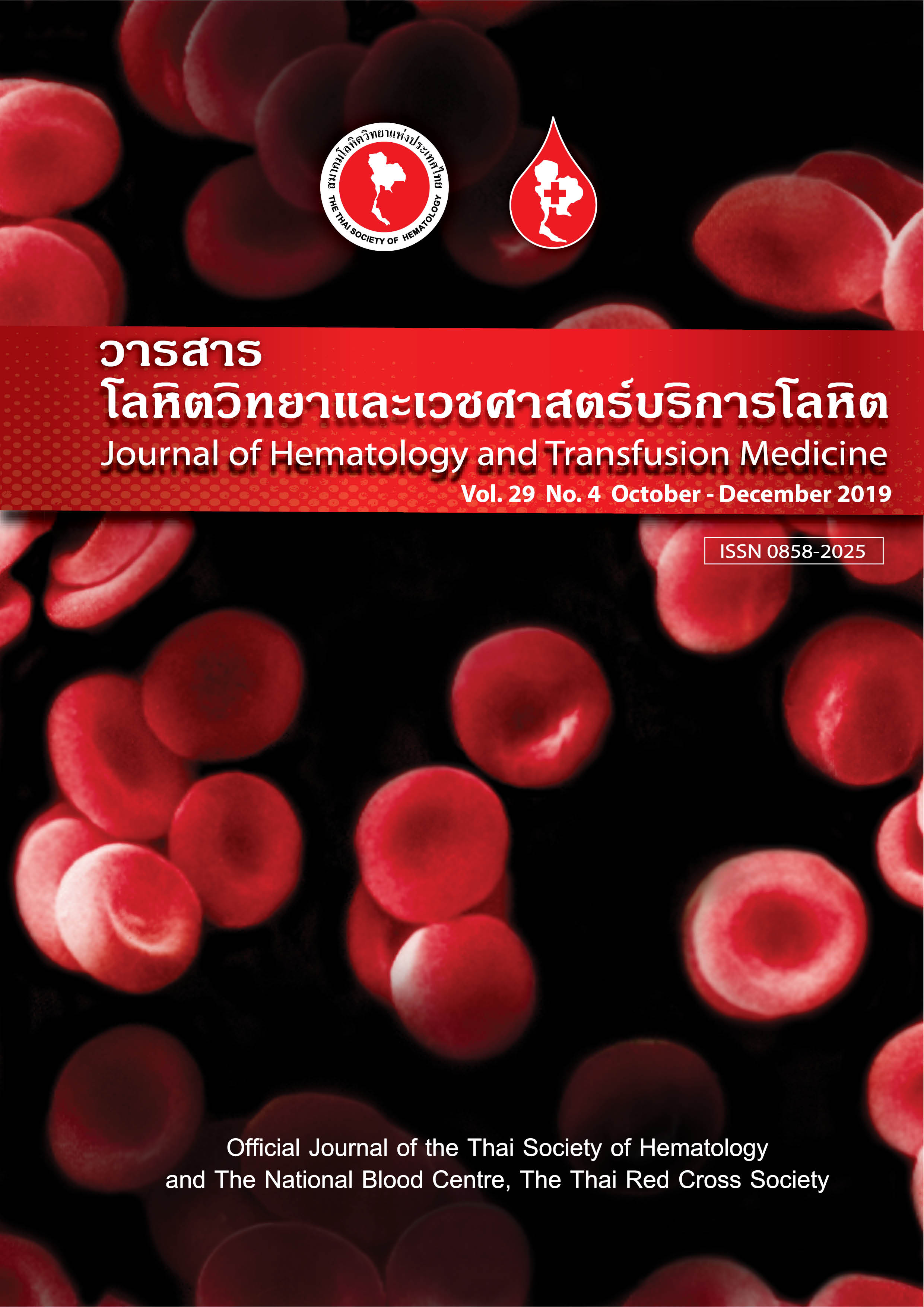การประเมินคุณภาพการตรวจหมู่เลือด ABO, Rh(D), antibody screening และ antibody identification ของห้องปฏิบัติการธนาคารเลือดในประเทศไทย พ.ศ. 2561
Keywords:
ABO grouping, Rh typing, Unexpected antibody screening test, Unexpected antibody identificationAbstract
บทคัดย่อ
บทนำ ห้องปฏิบัติการทางธนาคารเลือดต้องเข้าร่วมในโครงการทดสอบความชำนาญในการประเมินความสามารถของห้องปฏิบัติการ ซึ่งจัดโดยองค์กรภายนอก วัตถุประสงค์ เพื่อศึกษาคุณภาพการตรวจหมู่เลือด การตรวจกรองหาแอนติบอดีและบอกชนิดของแอนติบอดีที่พบของห้องปฏิบัติการทางธนาคารเลือดในประเทศไทย พ.ศ. 2561 วัสดุและวิธีการ ผู้จัดโครงการส่งตัวอย่างทดสอบที่เตรียมจากผู้บริจาคเลือดให้ห้องปฏิบัติการที่เป็นสมาชิก ปีละ 3 รอบ รอบละ 2 ชุด เพื่อทำการตรวจวิเคราะห์ ABO, Rh(D), antibody screening และ antibody identification ผู้จัดโครงการจะประเมินห้องปฏิบัติการที่ส่งผลครบทั้ง 3 รอบและให้คะแนนจาก 2 ส่วน คือ การตรวจวิเคราะห์และความถูกต้อง คะแนนรวมเท่ากับ 4 คะแนน โดยมีเกณฑ์ยอมรับที่คะแนนมากกว่าหรือเท่ากับ 3.0 ผลการศึกษา ห้องปฏิบัติการธนาคารเลือดเข้าร่วมทั้งหมด 1,102 แห่ง ผ่านเกณฑ์ร้อยละ 93.45 (15,299/16,371 รายงาน) และไม่ผ่านเกณฑ์ร้อยละ 6.55 (1,072/16,371 รายงาน) ห้องปฏิบัติการภาครัฐในภาพรวม ไม่ผ่านเกณฑ์ร้อยละ 8.39 โดยเฉพาะโรงพยาบาลชุมชนไม่ผ่านเกณฑ์ร้อยละ 10.90 ห้องปฏิบัติการสังกัดกระทรวงสาธารณสุขและนอกสังกัด ไม่ผ่านเกณฑ์ร้อยละ 8.66 และ 2.01 ตามลำดับ สำหรับเขตสุขภาพที่รายงานผลไม่ผ่านเกณฑ์มากที่สุด 3 อันดับแรก คือ เขต 8, 12 และ 6 (ร้อยละ 12.57, 9.93 และ 9.33 ตามลำดับ) สรุป การตรวจหมู่เลือดและการตรวจหาแอนติบอดีของหมู่เลือดของห้องปฏิบัติการทางธนาคารเลือดในประเทศไทยส่วนใหญ่มีคุณภาพ มีบางแห่งที่ไม่ผ่านเกณฑ์เนื่องมาจากความไม่ครบถ้วนของรายการทดสอบและวิธีที่ตรวจไม่ถูกต้องตามวิธีมาตรฐาน จำเป็นต้องได้รับการพัฒนาด้านเทคนิคและด้านการบริหารจัดการให้เหมาะสมดียิ่งขึ้นต่อไป
Abstract:
Background: Blood bank laboratories should participate a proficiency testing program which is set up by other organization to evaluate their laboratory performance. Objective: This study aimed to provide a quality assessment of blood bank laboratories in Thailand for the fiscal year 2018. Materials and Methods: Test items prepared from blood donors were sent to the participants in 3 rounds, 2 sets each, for analyses of ABO, Rh(D), antibody screening and antibody identification. The program organizer will evaluate only the participants which report the results of all 3 rounds and grade the reports from 2 parts, namely, the method of analysis and the accuracy of the reports. The total score is 4 points, with the acceptant criteria of greater than or equal to 3.0. Results: Among the total of 1,102 participants, 93.45% (15,299/16,371 results) passed the acceptant criteria and 6.55% (1,072/16,371 results) of unacceptable results were observed. The overall number of government blood bank laboratories who did not pass the acceptant criteria were 8.39% which 10.90% were observed in the community hospital blood banks. In addition, the number of blood bank laboratories under the Ministry of Public Health (MOPH) that did not pass the acceptant criteria were 8.66%. The top three highest unacceptable results were observed from health district laboratories 8, 12 and 6 (12.57, 9.93 and 9.33%, respectively). Conclusion: Most blood bank laboratories in Thailand passed the acceptant criteria. But some blood bank laboratories were not met the acceptant criteria due to insufficient list of tests and the testing methods used are not the standard methods. Therefore, technical and management improvement must be appropriately provided.
Downloads
References
2. Downes KA, Shulman IA. Pretransfusion testing practices in North America, 2005–2010, an analysis of the college of American pathologists interlaboratory comparison program J-Survey data, 2005–2010. Arch Pathol Lab Med. 2012;136:294-300.
3. ISO 9001:2015. Quality management systems - requirements. Geneva: International Organization for Standardization; 2015.
4. ISO 15189:2012. Medical laboratories - requirements for quality and competence. Geneva: International Organization for Standardization; 2012.
5. Buchta C, Coucke W, Mayr WR, Miiller MM, Ceser R, Schweiger CR, et al. Evidence for the positive impact of ISO 9001 and ISO 15189 quality system on laboratory performance – evaluation of immunohaematology external quality assessment results during 19 years in Austria. Clin Chem lab Med. 2018;56:2039-46.
6. De la Salle B. Survey material choices in haematology EQA: a confounding factor in automated counting performance assessment. Biochemia Medi. 2017;27:63–72.
7. ISO/IEC 17043:2010. Conformity assessment - general requirements for proficiency testing. Geneva: International Organization for Standardization; 2010.
8. Sciacovelli L, Secchiero S, Zardo L, Zaninotto M, Plebani M. External quality assessment: an effective tool for clinical governance in laboratory medicine. Clin Chem lab Med. 2006;44:740-49.
9. Dividing the health zone according to order of the Ministry of Public Health, 113/2015 dated 23 January 2015.
10. Klomklaeng A. Participant manual for national external quality assessment scheme in blood group serology: 2018. Nonthaburi: Bureau of Laboratory Quality Standards, Department of Medical Sciences; 2018.
11. Comparison of two proportion. Medcalc easy-to-use statistical software. [cited 2019 Mar 1]; Available from: https://www.medcalc.org/manual/comparison_of_proportions.php.
12. Klomklaeng A. Annual report for national external quality assessment scheme in blood group serology-2013. Nonthaburi: Bureau of Laboratory Quality Standards, Department of Medical Sciences; 2013.
13. Klomklaeng A. Annual report for national external quality assessment scheme in blood group serology-2014. Nonthaburi: Bureau of Laboratory Quality Standards, Department of Medical Sciences; 2014.
14. Klomklaeng A. Annual report for national external quality assessment scheme in blood group serology-2015. Nonthaburi: Bureau of Laboratory Quality Standards, Department of Medical Sciences; 2015.
15. Klomklaeng A. Annual report for national external quality assessment scheme in blood group serology-2016. Nonthaburi: Bureau of Laboratory Quality Standards, Department of Medical Sciences; 2016.
16. Klomklaeng A. Annual report for national external quality assessment scheme in blood group serology-2017. Nonthaburi: Bureau of Laboratory Quality Standards, Department of Medical Sciences; 2017.
17. Silva P, Soisangwan P. External quality assessment in ABO and Rh(D) blood groupings for performance evaluation of Thai laboratories, 2002-2005. J Hematol Transfus Med. 2007;17:73-84.
18. Urairong K, Yeekian C. Transfusion reactions and transfusion associated errors. J Hematol Transfus Med. 2013;23:195-202.
19. Chanachaisuwan P. Adverse effects of blood transfusion and transfusion error at police general hospital. J Hematol Transfus Med. 2006;16:283-96.
20. Chuan-Liang K, Yang-Yang H, Whay-Sue L, Lei-Fa C, Dong-Tsamn L. Survey of external quality assessment scheme for blood bank laboratories in Taiwan. Int J Bio Lab Sci. 2011;1:1-14.
21. Bejrachandra S, Saipin J, Nathalang O, Siriboonrit U, Rungroung E, Udee S. External quality assessment scheme in red blood cell serology: a 5-year experience in Thailand. [internet] 2006. [cited 2019 Mar 1]; [about 1 p.]. Available from: https://www.ncbi.nlm.nih.gov/pubmed/16563044.
22. Young AL, Hyun SC, Seog WK, Kye CK, Shin YK, Kyung UP, et al. Annual report on the external quality assessment scheme for blood bank tests in Korea (2015). J Lab Med Qual Assur. 2016;38:
59-67.



